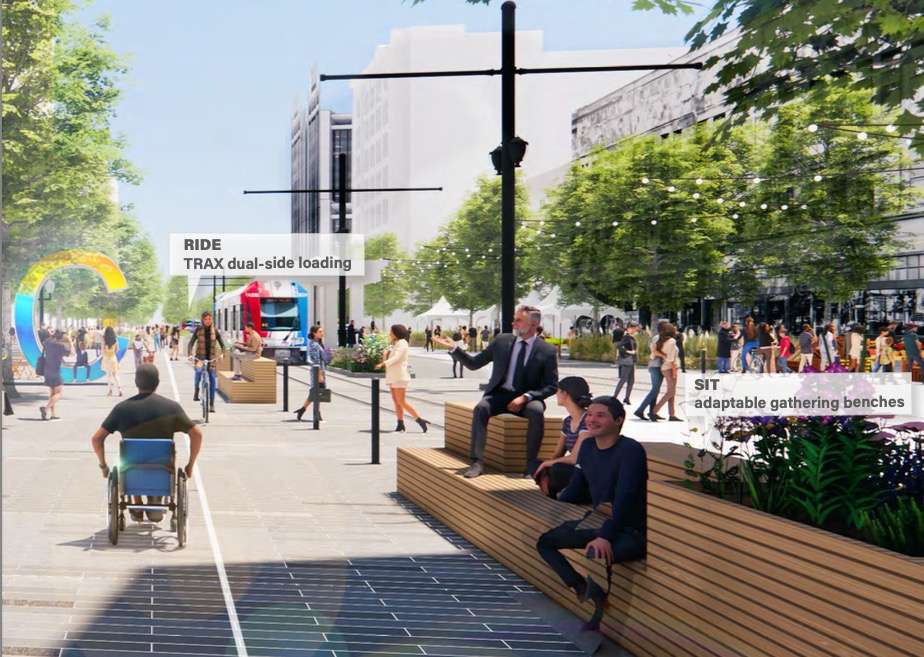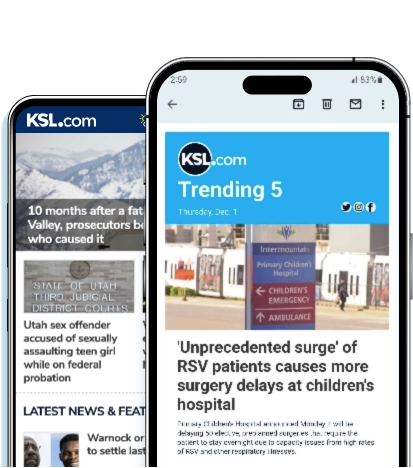Estimated read time: 5-6 minutes
This archived news story is available only for your personal, non-commercial use. Information in the story may be outdated or superseded by additional information. Reading or replaying the story in its archived form does not constitute a republication of the story.
SALT LAKE CITY — It's difficult to predict what the future will look like, but Salt Lake City Mayor Erin Mendenhall and other city leaders are very confident that Salt Lake City will look completely different by the time the Winter Olympics and Paralympics return in 2034.
"Salt Lake City is not going to look the same in 10 years," the mayor said shortly after Salt Lake City locked down its bid to host the global event on Wednesday.
That transformation, she added, was coming regardless of the Olympics, and it's already underway. Over the past year or two, the city and other entities have unveiled multiple large-scale projects that will radically transform the city, especially its downtown core.
With the bid now secure, these projects could become a reality by 2034 because the Olympics is expected to unlock a wave of new federal funds, much like the 2002 Winter Olympics did. Salt Lake City Councilman Alejandro Puy, who joined his colleagues at an early morning viewing party outside of City Hall to watch the Olympic announcement, said the city is already compiling a "big laundry list of needs" that could be addressed.
"It's a huge deal. ... Hopefully, it'll make an impact — after the Games are done — for decades," he told KSL.com. "Many of the older (residents) who participated in the (2002) Olympics saw Utah change because of the Olympics, so I think the bar is high, and we cannot disappoint."
That starts with downtown.
Downtown's pending growth
Salt Lake City has already changed since it hosted the 2002 Winter Olympics and Paralympics. Its population is now about 210,000, its highest point in history and nearly 30,000 more than in 2002.
That's not the only change. Once a mix of residents and businesses before the suburban flight of the 1960s, office workers were the biggest driver of downtown visitation at the time of the 2002 Winter Olympics. This remained the case until the COVID-19 pandemic, which changed everything.
The social economy — people coming to bars, restaurants or other activities — took over. While new office spaces have opened up since the pandemic, this trend hasn't changed. It's a big reason developers are building residential high-rises and converting old office towers into housing.
Downtown's residential transformation is already underway. The Worthington, a 31-story apartment high-rise, opened in June, and Astra Tower, the state's tallest building, is slated to open next month, among the larger projects. Downtown's population is projected to double from about 4,900 in 2022 to 10,000 in 2025, the University of Utah Kem C. Gardner Policy Institute estimated last year.
The number of people living downtown is expected to reach 14,000 by 2034, nearly triple its 2022 population, according to new Salt Lake City Downtown Alliance projections. The number of downtown workers is expected to reach 35,000, a 34% increase.
However, these could be conservative estimates.
"Frankly, it may be too modest," said Dee Brewer, executive director of the Downtown Alliance, explaining that he's aware of multiple private developers who are now considering "very ambitious" residential towers that would reshape the downtown skyline yet again.
On top of that, he told KSL.com that the University of Utah has expressed interest in building new student housing, programs and colleges downtown. Smith Entertainment Group is also eyeing residential towers within its major downtown revitalization project, and that could change the numbers.
The city recently approved zoning changes that removed most downtown building height limits, while Smith's proposed plan could open the door for building height caps of 600 feet. Recent projects have also centered on multifamily housing to bring families back to downtown.
These factors can drastically alter what type of population exists in 10 years.
"Increasing building height means that we can achieve density," Brewer said. "You may look at that positively or negatively, but there are good things that come out of strengthening downtown with more people living here."
A unique opportunity
That type of growth calls for all sorts of new amenities, including more infrastructure and green space. Those highlight many of the large-scale projects that the city is trying to accomplish ahead of the Games, but these are also the types of projects that Mendenhall said the city would push even if it lost out on its Olympics bid.
Since no new venues are needed for Salt Lake City to pull off the 2034 Games, Gov. Spencer Cox said Utah has a unique opportunity to dream of large-scale projects to improve the state.
"I believe the transformation of downtown Salt Lake City is the biggest thing that we can be working on right now," he said last week.

Smith's plan to remodel the Delta Center and build an entertainment district around it has garnered the most attention this summer as Utah welcomes in a National Hockey League franchise, but it's far from the only project that would drastically change downtown.
Large-scale projects that could transform downtown/surrounding area by 2034
- Downtown Revitalization District: Salt Lake City and Smith Entertainment Group reached a tentative agreement earlier this month on a revitalization district plan surrounding a remodeled Delta Center for the Utah Jazz and Hockey Club. The plan still has a way to go but could include a new entertainment district east of the arena with new buildings and a plaza over 300 West that could be tunneled underground. There's a clause saying that all Smith projects supported by possible public funds must be complete by 2034. The massive project may also include a rebuilt Utah Museum of Contemporary Art and a renovated Abravanel Hall. The company says it will direct $3 billion in private funds to the project, but it can get up to $900 million in bonds too.
- Gallivan Plaza: The Redevelopment Agency of Salt Lake City is currently working on a 20-year master plan that highlights future changes to the downtown plaza.
- Green Loop: Salt Lake City unveiled its plans and later concept designs for a "green loop" of trails and park space surrounding downtown last year. Updates on the project are expected to pick up soon.
- Main Street Promenade: Salt Lake City unveiled concept designs earlier this year on how it could turn Main Street into a walkable promenade with various districts on each block from 400 South to South Temple. It's estimated to cost $125 million.
- Pioneer Park: Salt Lake City has a plan to revamp the downtown park. The city directed $3.4 million in impact fee funds in 2019 and $10 million from a sales tax bond in 2022 toward the project. It's unclear when construction will begin.
- Rio Grande District: Redevelopment Agency of Salt Lake City's plan to transform 11 acres near the Rio Grande Depot, anchored by USA Climbing's proposed new headquarters. The project would essentially extend the downtown footprint westward.
- Rio Grande Plan: A resident-led plan — with city interest — that would bury the rails that run just west of downtown through a train box. UTA's FrontRunner would potentially use the Rio Grande Depot as a station. Salt Lake City published a screening analysis late last year, estimating that it could cost $3-5 billion to carry out.
- TechLink: Utah Transit Authority wants to move forward with its proposed light-rail extension that would link the University of Utah's Research Park to the Salt Lake City International Airport via a new line deeper into the core of downtown Salt Lake City. UTA director Jay Fox told KSL.com earlier this month that he'd like to see the new orange TRAX line complete by 2034.
The Smith project also has the most attached funding, as the proposed deal would allow for up to $900 million in bonds that could be repaid through a 0.5% sales tax revenue collection over the next 30 years — if finalized.
Unlocking federal funds would offer the city and state an opportunity to complete many of the other projects by 2034. Both Puy and Cox said requests would pick up once the bid was finalized.

Brewer says he believes projects with green spaces — parks and the Green Loop — may have the strongest case along with transportation projects like a downtown TRAX expansion or the Main Street Promenade. The latter is because Main Street's aging sewer infrastructure needs to be replaced anyway.
Should it all come together, people arriving for the 2034 Olympics may find a downtown that has grown taller with more pedestrian plazas, transit and green space than today. They may find more people living in the core of the city and more businesses and buildings tailored to community needs, including restaurants, stores and possibly a school one day.
If that's the case, Brewer said he hopes it only offers existing downtown businesses an opportunity to grow.
"We were already on that trajectory," he said. "(We need to make) sure that these investments are made from a holistic perspective that lifts up the entire downtown area."









